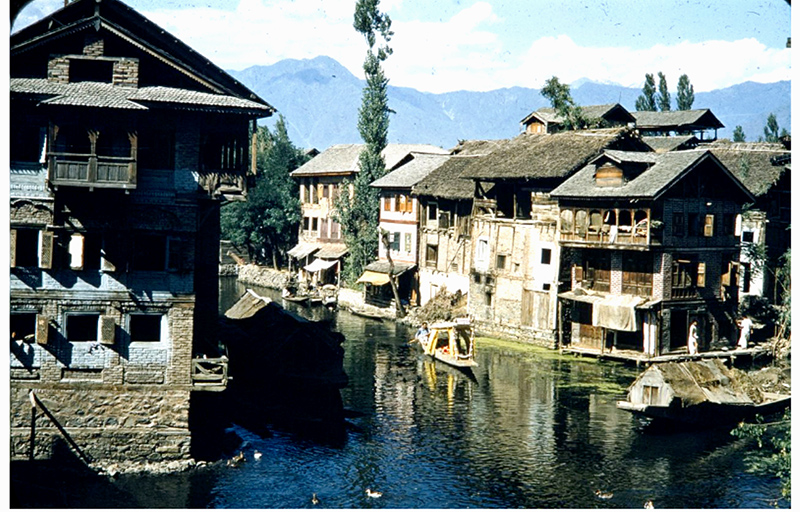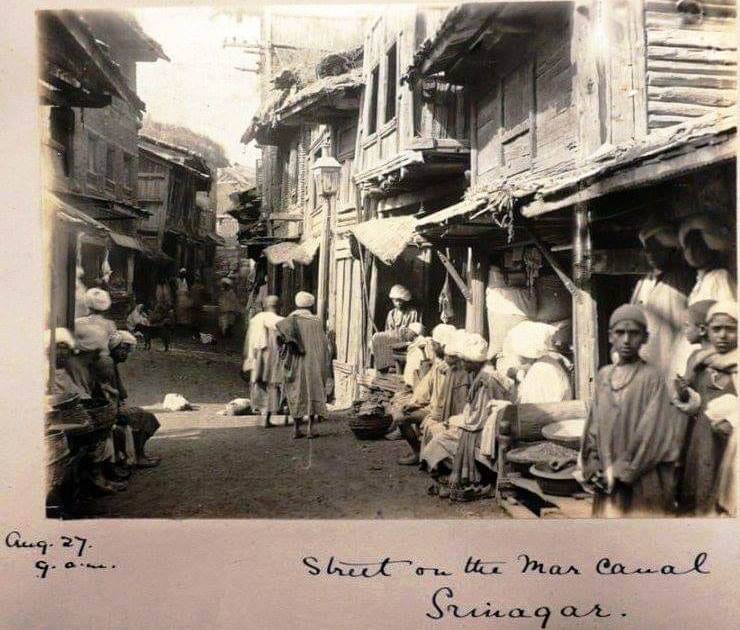For ages, rulers in Kashmir have constructed canals to improve life and production. But there is no ruler who could come even closer to Budshah. While most of them survived for half of the last millennium, Shams Irfan laments the loss of Nallai Mar

“No ruler of Kashmir has contributed towards building the country, promoting agriculture and digging canals of water as much as Budshah,” wrote the author of Tabkat-e-Akbari. Though creating new water canals has remained a routine with most of the rulers of Kashmir, it was only during Budshah’s reign that an elaborate irrigation canal structure took place across Kashmir, including Srinagar. Some of these canals still exist and operate.
It all started with Lal Kohal. Originating from the brooks of Nala Pohroo and Lolab, the canal, after travelling a distance of about forty miles, joins Jhelum at Doaab Gah near Sopore.
The purpose of Lal Kohal was to irrigate Zainageer and its adjoining villages. For this purpose Budshah ordered construction of a strong bund (embankment) of stones near Bunagam Pohroo. Also, one of Lal Kohal’s major branch irrigated villages like Zolrah, Harvan, Lateshat, Nawpora, Tujar, Zaina Pora, Bumy, Goripora and Seelo.
A few minor branches of Lal Kohal were used to supply water to places like Doru and DarPora.
But its main purpose was to keep Zainageer belt irrigated as the area was inhabited by Budshah himself. He had built a palace in the belt and would frequently visited and stay there. One major factor for frequenting the belt was that Chak’s were concentrated in the area and would occasionally attack his cavalry or the assets. They destroyed his Sopore palace twice.
Even after five hundred years this canal is still in operation and is irrigating the vast belts of Tujar, Bumy, Doru and Sopore.
Shah Kohal
When Budshah took the reign of Kashmir, the plateau of Martand, in the southern part of the valley, was barren and bereft of any plantation. It pained Budshah who ordered the construction of a canal that will be fed by Lidder River.
The sixteen-mile long canal that originated at Ganesh Pore and ended at the pleatue of Martand, irrigated around forty villages in between.
However historians point out that around seven hundred years before Budshah decided to construct Shah Kohal, a Hindu king named Lalitaditya (ruled 715 AD- 752 AD) had built a canal to feed habitations around Martand temple.
Lalitaditya’s canal originated at Ganesh Pora drawing water from Lidder and ended at Martand. Historians like Pandit Kalhana, Praja Bhat and Shak Joo have written in detail about orchards full of grapes in Martand. However, after the death of Lalitaditya, the temple and the city around it was left to ruin. When Budshah visited the plateau in Martand, he immediately ordered the construction of Shah Kohal so that the entire area is cultivated once again.
The sixteen mile long canal that originated at Ganesh Pore and ended at the pleatue of Martand, irrigated around forty villages in between.
Budshah employed thousands of labourers to dig the canal. After the Shah Kohal became functional, the famous Martand plateau once again came to live with orchards of grapes and other fruits.
Historian Shrivara writes in his Raj Trangnni, “These grapes were famous far and wide because of their sweetness and plumpness.”
However, by the time Dogras took over the infrastructure created by Budshah was in ruins because of neglect.
After Maharaja Ranbir Singh resettled this plateau in 1919 (Bikrami calendar), he ordered the repairs on Shah Kohal. However, despite repairs and rebuilds, the water cannot move beyond Salia.
After him, Mahraja Pratap Singh took up the project and got the canal repaired once again in 1955 (Bikrami Calendar).
But unlike Budshah the Dogra ruler of Kashmir imposed a tax on farmers for using the waters of Shah Kohal. The irrigation tax was part of the state’s revenue structure till recently and was done away with only in 2003. The reasons for withdrawing this tax was that state spent more on collecting this money than the total fund collection!

An image of 1957
Nallai Mar
Sheikh Abdul Wahab Noori Ganai writes in his book ‘Fatheyat-e-Kubraviah’ that during old days the water of Dal passed through Mohalla Alla-ud-Din Pur via Brari Nambal.
It gave Budshah idea to utilize the same for two purposes: to irrigate Pargana Achan and to make this water available to people in Idgah for survival.
However, the idea of constructing such a huge canal was not an easy task to undertake. There is an interesting story behind the construction of Srinagar’s Nallai Mar .
While Budshah was contemplating a plan to build Nallai Mar, a snake came into his dreams. The snake crawled through the proposed route and made his way to the end. The next morning when Budshah got up he heard commotion outside his palace. When he went out to check, he saw people chasing a snake trying to catch it. But the reptile was too quick and crawled all the way to Idgah and then to Achen where it disappeared.
The incident, historians believe, gave Budshah cue about the route of water for the Nalai (canal) Mar (snake in Persian).
However historian Sir Aurel Stein, who translated Rajatarangini from Sanskrit to English, writes that a canal or a brook already existed there. It was perhaps called Mahasarat. Stein believes that Budshah might have revived the same canal and named it Nallai Mar .
It gave Budshah idea to utilize the same for two purposes: to irrigate Pargana Achan and to make this water available to people in Idgah for survival.
Budshah joined Nallai Mar with Shali Nahar at Masti Karan. The Shali Nahar extended up to Shadi Pore (originally called Shahab-ud-Din Pore), the meeting point of River Sind and Jhelum.
Later historians believe that extension of Nallai Mar on its western side is a later development. Budshah made this route navigable for boats as well.
This proved crucial for the transportation of goods and vegetables from Dal Lake to the markets in the city by boats.
Later, three branches were added to the Nallai Mar to reach out to areas like Kawdara, Baramal and Danlat Kal. The demand for adding more channels to the localities was because water is like a road and most of merchandise was transported through water channels.
The chief purpose of this canal, however, was to provide water to Aali Masjid, built by Budshah’s elder brother, Ali Shah, the former king of Kashmir and to Idgah. But Budshah made sure that this water is also utilized for the irrigation of Pargana Achan via Idgah.
Nallah Mar’s take off point was Brari Nambal lagoon. It had two diversions: one passed through Eidgah into Khushalsar, Gilsar and emptied into Anchar Lake and, other through Noor Bagh into the River Jehlum.

With Kashmir’s fortunes changing with the change of rulers the preservation of Nallai Mar was not a priority anymore.
During G M Sadiq’s government, this canal was completely left to rot for want of attention and repair. The channel became stinking spot as its disuse helped people to throw their dirt into this. When the channel was in operation, the elite and the high officers of subsequent governments would live on its banks. It would get them closer to the water-way and make their movement easy. But once it became a stinking spot, it was a major crisis, especially after the road transport gradually set in.
During G M Sadiq’s government this canal was completely left to rot for want of attention and repair.
However in 1975, a major road in old town Srinagar was constructed by filling up Nallah Mar, which traversing through the city. Its filling was literally celebrated by parts of Srinagar, especially those directly impacted by the decision. The real estate prices were up. A new market was created and everybody was happy.
This road did help in easing the connectivity issues to an extent but completely choked the water bodies connected to the Nallai Mar .
Once known as Venice of East, Srinagar had a number of streams that crisscrossed the city and Nallai Mar was the most important one.
The filling of Nallai Mar led to stagnation of Brari Nambal lagoon and choked Dal Lake too. This careless planning disaster turned Brari Nambal, which once had clean fresh water, into a stinking cesspool.

Locals recall how Nallai Mar was an important link in connecting the business centre of Srinagar city. Over the years a number of bridges were laid over Nallai Mar including, Nowpora Kadal, Naid Kadal, Bohri Kadal, Saraf Kadal, Kaid Kadal, Rajouri Kadal, Kaw daer Kadal, or Pachi Kadal, Dumbi Kadal,Taribal, Narwar (Buti Kadal)
After the disastrous floods of September 2014, Nallai Mar was back in focus. A lot of commentaries were in public domain suggesting that had the canal existed, it would have helped Srinagar drain faster and minimized the losses, especially in Dalgate-Munwar belt.
Zain Ganga Canal
Another important project that Budshah undertook in his five decade long rule was Zain Ganga Canal.
The said canal was conceived to provide water to Zaina Pore, a city inhabited by Budshah. This place is in present day Shopian district. Once the area became irrigated and prospered accordingly, Budshah ordered building of rest houses and other government structures. His officers also followed Budshah’s suit and constructed a number of beautiful structures in Zaina Pore. There are references of beautiful “enviable” gardens in this city that Budshah built.















